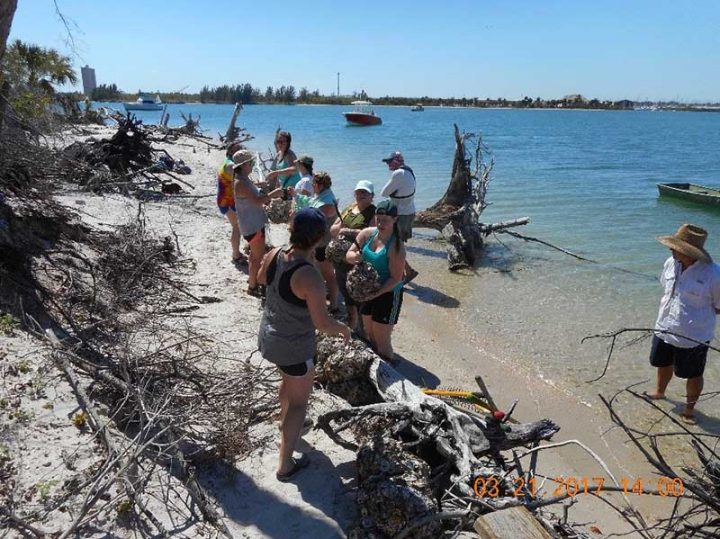
The St. Lucie County Artificial Reef Program utilized the hard-working Plymouth State University Alternative Spring Break (ASB) to help with habitat restoration projects from March 20th through March 24th. Hosted by the City of Fort Pierce’ Manatee Observation and Education Center, the ASB has called Fort Pierce its spring break home for the third consecutive year, helping with activities at the Manatee Center and contributing to the health of our local waters.
The ASB worked on projects including an inshore artificial reef and snorkeling trail, planning for a living shoreline to protect a failing seawall, oyster reefs, and Wesley’s Island habitat restoration. Their work compliments the efforts of dedicated residents concerned with the health of our waters and natural resources. Constructing oyster reef modules from a new biodegradable netting developed by the Kaneka Corporation and Polymer Processing, Inc., these students deployed 100 square feet of intertidal oyster reef in a section of Wildcat Cove on a fossilized oyster bed. Oysters had proliferated at Wildcat Cove before Hurricanes Francis and Jean delivered silt to the area, killing many of the oysters in 2004. The deployment of this oyster reef was monitored by volunteers from the Coastal Conservation Association to ensure the safety of all involved. Members from the Kaneka Corporation and Polymer Processing traveled from Japan and Texas, respectively, to observe the first use of their experimental mesh.
ASB students also used oyster reef modules to help reduce erosion on Wesley’s Island’s northwest shoreline. These modules were placed above the mean high water mark to help prevent sediments from eroding from the escarpment into the water. Native vines and other vegetation will be planted to hold the sediments in place. Once these plants have matured and permits for another oyster reef are obtained, the oyster reef modules will be moved waterward to create another oyster reef to provide additional fish habitat.
In addition, ASB students removed the Balsam pear vines from the coastal grasslands. In September, these grasslands were planted by volunteers under the guidance of the County’s Environmental Resources Department (ERD) but sections had since been overgrown by the invasive vine. The students even developed a technique for rolling large areas of the vine to clear hammock areas for planting. Cabbage palms purchased at the second annual Wesley’s Island Pig Roast will be planted in areas just above the shoreline to give shade to boaters enjoying the island. Tree Planters of South Florida has already donated the first cabbage palm to be displayed at the Second Annual Wesley’s Island Pig Roast. It is hoped that other community members at the festival will purchase additional cabbage palms with which to replant the island.
When the rainy season starts, plants obtained from the ERD’s native plant nursery will be planted in a series of volunteer work days, like those held last September. Boats from ERD, the Indian River Lagoon Aquatic Preserve, and the Indian River Lagoon Boat Tours, and the One Florida Foundation, as well as other boats and volunteers participated in this planting.
If interested in learning more on the St. Lucie County Artificial Reef Program or about college groups visiting St. Lucie County, contact Jim Oppenborn, St. Lucie County Coastal Resources Coordinator at oppenbornj@stlucieco.org or (772)462-1713.




